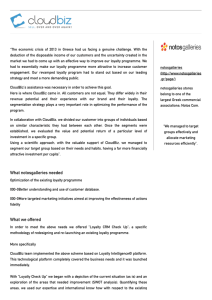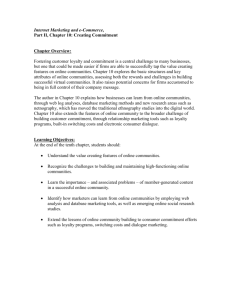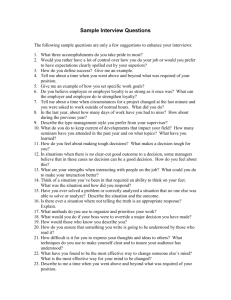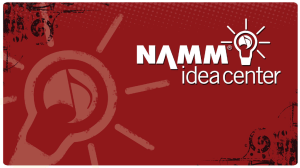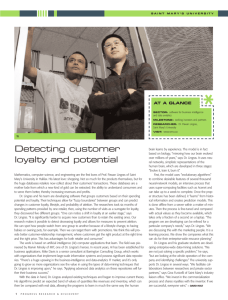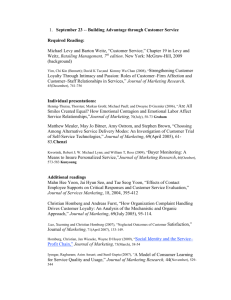Communication and organizational culture
advertisement
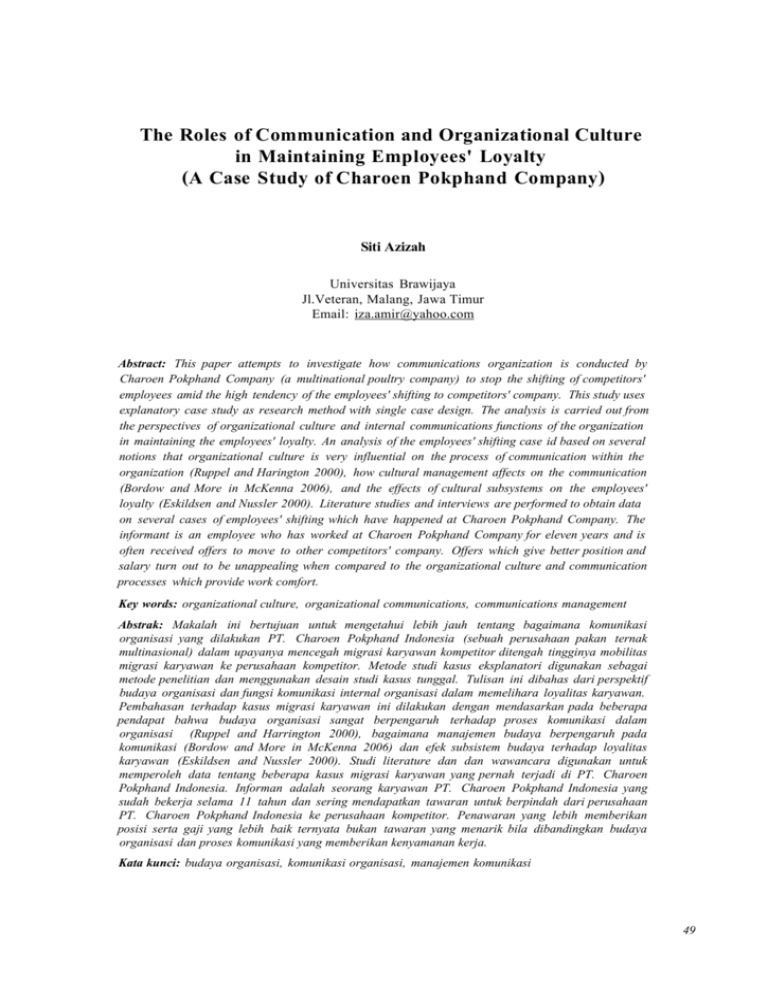
The Roles of Communication and Organizational Culture in Maintaining Employees' Loyalty (A Case Study of Charoen Pokphand Company) Siti Azizah Universitas Brawijaya Jl.Veteran, Malang, Jawa Timur Email: iza.amir@yahoo.com Abstract: This paper attempts to investigate how communications organization is conducted by Charoen Pokphand Company (a multinational poultry company) to stop the shifting of competitors' employees amid the high tendency of the employees' shifting to competitors' company. This study uses explanatory case study as research method with single case design. The analysis is carried out from the perspectives of organizational culture and internal communications functions of the organization in maintaining the employees' loyalty. An analysis of the employees' shifting case id based on several notions that organizational culture is very influential on the process of communication within the organization (Ruppel and Harington 2000), how cultural management affects on the communication (Bordow and More in McKenna 2006), and the effects of cultural subsystems on the employees' loyalty (Eskildsen and Nussler 2000). Literature studies and interviews are performed to obtain data on several cases of employees' shifting which have happened at Charoen Pokphand Company. The informant is an employee who has worked at Charoen Pokphand Company for eleven years and is often received offers to move to other competitors' company. Offers which give better position and salary turn out to be unappealing when compared to the organizational culture and communication processes which provide work comfort. Key words: organizational culture, organizational communications, communications management Abstrak: Makalah ini bertujuan untuk mengetahui lebih jauh tentang bagaimana komunikasi organisasi yang dilakukan PT. Charoen Pokphand Indonesia (sebuah perusahaan pakan ternak multinasional) dalam upayanya mencegah migrasi karyawan kompetitor ditengah tingginya mobilitas migrasi karyawan ke perusahaan kompetitor. Metode studi kasus eksplanatori digunakan sebagai metode penelitian dan menggunakan desain studi kasus tunggal. Tulisan ini dibahas dari perspektif budaya organisasi dan fungsi komunikasi internal organisasi dalam memelihara loyalitas karyawan. Pembahasan terhadap kasus migrasi karyawan ini dilakukan dengan mendasarkan pada beberapa pendapat bahwa budaya organisasi sangat berpengaruh terhadap proses komunikasi dalam organisasi (Ruppel and Harrington 2000), bagaimana manajemen budaya berpengaruh pada komunikasi (Bordow and More in McKenna 2006) dan efek subsistem budaya terhadap loyalitas karyawan (Eskildsen and Nussler 2000). Studi literature dan dan wawancara digunakan untuk memperoleh data tentang beberapa kasus migrasi karyawan yang pernah terjadi di PT. Charoen Pokphand Indonesia. Informan adalah seorang karyawan PT. Charoen Pokphand Indonesia yang sudah bekerja selama 11 tahun dan sering mendapatkan tawaran untuk berpindah dari perusahaan PT. Charoen Pokphand Indonesia ke perusahaan kompetitor. Penawaran yang lebih memberikan posisi serta gaji yang lebih baik ternyata bukan tawaran yang menarik bila dibandingkan budaya organisasi dan proses komunikasi yang memberikan kenyamanan kerja. Kata kunci: budaya organisasi, komunikasi organisasi, manajemen komunikasi 49 Jurnal ILMU KOMUNIKASI In a real world, employees' loyalty and employees "stealing" between companies have been difficult problems for most companies, especially when skills and experiences are costly and valuable. Sometimes, a competitor takes benefit from other company's unfavourable organizational culture and poor communication to get qualified employees. It is interesting to find out the causes why this phenomenon often happens in certain companies while others are able to manage and prevent them. One assumption underlying the success of tackling employees stealing is how the company maintains its comfortable culture and good communication management for its employees to keep them from other companies' "temptation". For years, Charoen Pokphand Company has been succeeded to avoid employees shifting to other similar companies, at least a large numbers of shifting. This is very important since the company has to protect several internal materials that cannot be externally communicated to competitors. This paper aimed to look at the issue from the perspective of organizational communication, organizational culture and organization communication management. Hopefully, it gives a clear illustration how Charoen Pokphand Company deals with the issue. 50 VOLUME 8, NOMOR 1, Juni 2011: 49-59 METHODOLOGY This study used explanatory case study as research method with single case design. Researcher Robert K. Yin defines the case study research method as an empirical inquiry that investigates a contemporary phenomenon within its real-life context; when the boundaries between phenomenon and context are not clearly evident; and in which multiple sources of evidence are used (Yin, 1984). Data was gathered by using open questions. The key informant is CP employee who works for the company for eleven years and often get direct offers from other companies. Data from the key informant is then triangulated with data from the field in order to strengthen the research findings and conclusions. Charoen Pokphand and Competitor's Offer Issue Charoen Pokphand traces its beginnings back to 1921, when Ek Chor and Siew Whooy brothers started the Chai Tai seed shop in Bangkok's Chinatown (Wikipedia 2006). Since 1972 Charoen Pokphand (CP) has been operating in Indonesia and today it has two main business units: feed mill and poultry integration (Food and Agriculture Organization 2006). Siti Azizah, The Roles of Communication... As an agribusiness company, CP provides continuous trainings and significant amount of funds to enhance employees' skills and knowledge. If it fails to retain its employees, it will result costly losses to the company. According to Bigliardi, Petroni and Dormio (2005), a turnover results from a lack of commitment to an organization, and it causes significant expense to an organization. In 2002, a Korean based company gave an attractive offer (double salary and operational cars which would be privately owned within 3 years) for intermediate to high level CP employees. However, CP successfully retained its employees and only one employee in manager level took the offer. It was interesting since proper salary job is rare especially in developing country like Indonesia. This paper is aimed to focus on the role of organizational culture and communication element in maintaining employees' loyally in CP. As stated, both organizational culture and employees' withdrawal intentions and behaviours have long been important topics in organization science (Carmeli 2005). Ruppel and Harrington (2000) say that cultures (defined as the patterns of values, ideas, rituals and symbols in organisations that shape human behaviour), as well as the measurable climates within cultures, have been identified to facilitate communication. On the other hand, communication is also identified affecting organizational culture. Bordow and More propose ideas on managing organizational culture through communication in three ways: agenda setting, network building and dissemination (McKenna 2006). As a result, communication can improve organizational culture, and vice versa. Relationship between employees' loyalty and organizational culture is described by Eskildsen and Nussler (2000) in Figure 1 below. Figure 1. Causal Connection Model (Eskildsen and Nussler 2000) 51 Jurnal ILMU KOMUNIKASI They made the model based on McCarthy statement that the cultural subsystem must have a direct effect on both employees' satisfaction and loyalty (Eskildsen and Nussler 2000). According to Madsen, Miller and John (2005), loyalty to the company is determined by assessing an employee's intention to leave, particularly if additional compensation is offered by another firm. This is sensible because appropriate culture makes employees feel comfortable, in terms of feel secured, appreciated, heard, well influenced by communication practices as follow: 1) familiarity of the individuals in the relationship over a significant period of time; 2) shared experiences and goals; 3) reciprocal disclosure between and individuals over time; and 4) demonstration of non-exploitation expressed over time. The concept of the paper treated by management and got involved in organization programs. An employee, who feels respected and treated fairly, will not only trust the management, but the organization as well (Appelbaum, Bartolomucci, Beaumier, Boulanger, Corrigan, Doré, Girard, & Serroni 2006) Based on the explanation above, we can say that excellent communication and organizational culture in the end will enhance 52 VOLUME 8, NOMOR 1, Juni 2011: 49-59 employees' trust and loyalty. Dani, Burns, Blackhouse and Kochhar (2006) propose that trust is generally. is presented in figure 2. Figure 2. Paper Concept I Organiza- I Employee's loyalty (methods and Organizational Culture and Communication Organizational culture and communication in CP are discussed in this section. In the first part, organizational culture of CP is observed. In general, organizational culture is defined as shared philosophies, ideologies, values, beliefs, assumptions, expectations, attitudes, and norms (Hellriegel, Slocum and Woodman 1992). The paper uses Cameron and Quinn's classification to look at CP's organizational culture type (cited in Dani et al. 2006). Defining the type of organizational culture is one way to understand company's characteristics and priorities. Siti Azizah, The Roles of Communication... Charoen Pokphand tends to have Adhocracy culture features since the company predominantly has flexibility and individuality traits. Although CP can be categorised in Adhocracy culture, it seems impossible to strictly put an organization into one type since a company might have other types' characteristics. In this case, CP also shows slight competitive pricing and market leadership importance characteristics from the Market Culture. However, this matter is not part of analysis of the paper. CP's employees spend most of their time visiting farmers and company's branch, solving clients'/on farm problems independently, trying to give the fresh ideas to serve costumers and doing the research to improve quality of the products. These characteristics will be described in the daily practices of organizational culture below. As daily practice, Carmeli (2006) defined organization culture as follow: 1. Job challenge. This dimension refers to diversity and complexity in the work. Each employee in CP has special expertise and is required to manage a field that necessitates particular skills and knowledge. Clear job distinction and proper employee recruitment which is based on the speciality somehow make employees feel comfortable and find interesting things in their job. Bigliardi et. al. (2005) propose that the potential consequences of a lack of employee job fit include anxiety, strain, job dissatisfaction, and turnover, among others. 2. Communication. This dimension refers to effectiveness of communication between top management and employees, and amongst the employees themselves. The most obvious of open communication practice is an office arrangement in every branch of the company. Employees of the same level sit together in one big room without partition and higher level employees have an individual room with open doors. This situation enables every employee to make contact easily. In case employees are required to visit farmers and outdoor locations, employees-managers use cellular phone to communicate. Electronic communication and data transferring between employees and/or department are conducting by using Yahoo! messenger during working hours. Garton and Wellman (1995) found that when people communicate electronically, work groups become more fluid. People can participate actively in groups, and those on the periphery get more involved. 53 Jurnal ILMU KOMUNIKASI 3. Trust. This dimension refers to the trust that exists between employees and their managers and among themselves, a kind of trust, which enables free discussion and open-minded environment. Trust is reflected in the open-minded communication and free discussions, these activities are mostly made in informal situation. A lot of routine informal activities are done together in CP. prayer times (before lunch and after afternoon tea) and lunch time are used by employees to discuss about their job and the company problems, to share information and to build a rapport between them. Relax situations and discussions make everyone feels equal, closely involved with company and high sense of belonging. In formal condition, monthly meetings and irregular meetings also express open communication, although more delicate language is used regarding to Asian culture environment. According to Tracy in Appelbaum et. al. (2006) to increase the level of trust, managers need to assume a "coach approach" in their management style in order to develop and maintain trust among their employees. 4. Innovation. This dimension refers to a supportive environment for creativity, problem solving, new ideas and sustained development. 54 VOLUME 8, NOMOR 1, Juni 2011: 49-59 Innovation dimension in CP daily practice is revealed as a responsibility given to every employee. Since most of employees are posted on the farm, they need to have enough creativity and problem solving ability especially in urgent situation. Farming conditions often call for quick decision concerning disease spread, natural disaster or unexpected market situation, so at last employees become creative, trained and experienced. Although consultation needed, the company puts much trust on their ideas and decisions. The involvement of staff communicates the extent to which they are valued, organisations which use staff suggestions do not only benefit financially but are building up their employees' self esteem and commitment to the organization (Curtis and Wright 2001). 5. Social cohesion. This dimension refers to thesubstance of the interrelationships among the organization's members, and to the extent this interrelationship is featured by a sense of a cooperation and solidarity. Curtis and Wright (2001) say that a group cohesion that includes fitting in with the team or within colleagues is important to the development of an emotional attachment at work. Social events, team building Siti Azizah, The Roles of Communication... Curtis and Wright (2001) say that a group cohesion that includes fitting in with the team or within colleagues is important to the development of an emotional attachment at work. Social events, team building activities and a culture of co-operation, rather than competition, will all assist in making the new starter feel at home. In CP, the competition is not too obvious since every employee has different task and rarely works in the team (except in occasional moment e.g. monthly meetings or huge natural disaster). However, there was no report on total team work failure in the company. As described above, it is likely CP has a strong organizational culture, where the members are familiar to company's culture elements and not reluctant to actively participate as they feel comfortable to do them. McKenna (2006) explains the advantages of strong culture in organization as follows: 1. Facilitate goal alignment. All employees share the same basic assumptions. 2. Leads to high levels of employee motiva tion. High levels of motivations translate into high organisational performance. 3. Better able to learn from the past. This strong organizational culture can be preserved by applying appropriate communication methods and practices. Figure 3. Type of Organizational Culture (Dani et ah 2006) 55 Jurnal ILMU KOMUNIKASI As the organizational culture grows stronger, employees' trust and loyalty will be improved. McKenna (2006) mentions Bordow and More's ideas of managing an organizational culture through communication in three ways: agenda setting, network building and micro communication. Agenda setting is beneficial for a manager who keens to gain goal alignment between employees. If a manager can clearly deliver the message about company's problems, plans, and programs to employees, employees will feel involved and not feel left behind. Being regarded as an important part of the company will motivate employees to actively take part in conducting the company's agenda and to perform better. Agenda setting activities provide information that help company to comprehend any mistakes done in the past and to find out the solution in the current time and in the future. Network building is the most obvious method to connect organizational culture and communication practice. In network building activities, managers are encouraged to use both formal and informal communication 'as a means to an end and in service of the organisations' efficiency' (McKenna 2006). Formal and informal communication by organization members in CP have been described in details in the daily practices of organizational culture above. Micro communication or narrowcast function of dissemination can be an important means to facilitate goal alignment since it should be used to 'sell change at the local level' 56 VOLUME 8, NOMOR 1, Juni 2011: 49-59 (McKenna 2006). This function is very useful when a company experiences a significant change that might affect its employees. Employees need to be informed honestly about the changes and company's problems so they can contribute optimally because they realize that their contribution will affect them in the end. According to Argenti (1998), part of the problem at many companies is that senior managers simply do not involve other employees in most of the decision-making process. This tends to make them feel alienated and less willing to accept the changes that managers then impose upon them. Macro communication function is important to give accurate information both for internal and external parties, so outsiders (other stakeholders) will be informed the same things as insiders (organization members). This function will help to build trust in both parties to organization. Besides organizational culture and those three methods, a company also can use higher authorities' tasks such as roles of HRD managers and supervisors in creating safe and sound culture to maintain their subordinates' trust and loyalty. Morall (1999) says that management is responsible for fostering an atmosphere of special trust. In addition, it was found that trust and loyalty to supervisors sometimes greater than to organization. Studies have shown that trust in organizational authorities influences a variety of subordinates' work attitudes and behaviours. In general, employees are more supportive of or committed to authorities and the institutions that Siti Azizah, The Roles of Communication... the authorities represent, when trust is relatively high (Brockner, Siegel, Daly, Tyler and Martin 1997). A study done by Chen, Tsui and Farh (2002) shows that loyalty to supervisor seems to be more important than organizational commitment in accounting for employee's in-role and extra-role performances. Nonetheless, it is important to consider the effect of culture and individual leadership to employees' loyalty to their supervisors. For Asian culture, respect, trust and loyalty to higher authorities is tend to be bigger than to Western culture (Chen et. al. was conducting the study in China). Although nowadays this culture is vanishing, most of Asian people still consider treating authorized person's suggestion as a command. So, the result of the study might not applicable in every culture. Likewise, strong and acceptable individual leadership ability likely will create subordinates' trust and loyalty. In the case where a supervisor does not have sufficient skills in managing their subordinates, organizational commitment can be more important than to supervisors. Thus, supervisors and HRD managers should not fully believe in the study result, but also need to aware of the geographical culture and of their leadership ability. DISCUSSION From the literature search, there are two ways that can be used to improve and to maintain employees trust and loyalty, they are: 1. Identify and Take Benefit from Organizational Culture Type As defined above, CP likely has adhocracy culture which the company usually has high trust and low regulation (Dani et al. 2006). So in this case, if a regulation does not force employees to trust the company then informal method and communication should be appropriate ways to create and to sustain employees' trust. Guilbert and Tang in Appelbaum et. al (2006) found a strong positive relation between organizational trust and organization communication. They suggest that formal, but even more important, access to organizational communication channels enhances organizational trust. Giving reward to employees' success to create new ideas is one way to retain employees since an innovation is considered as a significant element in adhocracy culture. Informal communication from higher authority and some of formal ways such as ceremonies, rituals (e.g. meeting) can be used to reward employees' achievement. The 'feel good factor' concerning one's job is very essential for committed employees. Individuals should be clear about their responsibilities and performance standards, given positive feedbacks on how well they are doing and feel that performance assessments and appraisals are fair (Curtis and Wright 2001). Regarding on flexibility, a company has to consider giving supple decision to employees' problems in some important and sensitive areas. Thus employees feel free to communicate their ideas or anxieties, for example giving extraordinary ideas, family issues, and inability in carrying out particular task. In their research, Roehling, Roehling and Moen (2001) found that 57 Jurnal ILMU KOMUNIKASI employee loyalty is more strongly tied to the perceived flexibility and tolerance of the work environment than to work policies. 2. Using Supervisors/HRD Managers Roles Managers and supervisors' roles are proven can affect their subordinates' trust and loyalty to company. Therefore, a company should provides a proper training for HRD managers/supervisors to give profound understanding about the significance of organizational culture, its characteristics and suitable communication methods identification. Hopefully, they will be able to apply them in their leadership style and in relationship with subordinates. Keyton (2005) suggests that managers and leaders can (a) be aware of their organization's culture, (b) make conscious attempts to influence what cultural elements are interpreted and how they are interpreted, and (c) promote framing conditions to enhance the likelihood that certain ways of thinking, feeling, and behaving develop. By communicating what is important, managers can influence their organization's culture. Managers also should generate a daily work climate where employees feel considered as a part of the group and respected by other members. This is based on the core sets of needs that were related to belongingness by Ibrahim Maslow that we have a strong need to be part of groups or organizations, to feel wanted by people in them, and sense that we belong in them. In turn, we give our loyalty to them (Tourish and Hargie 2004). 58 VOLUME 8, NOMOR 1, Juni 2011: 49-59 SUMMARY Employees' trust and loyalty are strongly determined by organizational culture and communication methods. Based on this idea, failed offers from CP's competitor are then observed from the view of organizational culture and communication. Cultures effect on communication in organization (Ruppel and Harrington 2000), managing culture through communication (Bordow and More in McKenna 2006) and cultural subsystem effect on employees' loyalty (Eskildsen and Nussler 2000) are used to discuss the issue. The case analysis includes: 1) CP's organizational culture identification, and 2) CP's organizational communication management methods and practices. Two ways suggested to foster employees' trust and loyalty are: 1) identify organizational culture and take benefit from its characteristics, and 2) use higher authorities roles to create favourable work climate and to employ proper communication methods/practices. REFERENCES Appelbaum, S, Bartolomucci, N, Beaumier, E, Boulanger, J, Corrigan, R, Doré, I., Girard, C, & Serroni, C 2006, Organizational citizenship behaviour: a case study of culture, leadership and trust, viewed 1 October 2007, <www.emeraldinsight.com/0025-1747.htm>. Argenti, PA 1998, Corporate communication, 2nd edn, Irwin McGraw-Hill, New York. Bigliardi, B, Petroni, A, and Dormio, AI 2005, 'Organization socialization, career aspirations and turnover intentions among design engineers', Leadership and Organization Development Journal, vol. 25, no. 5/6, pg. 424¬ 438. Siti Azizah, The Roles of Communication... Brockner, J, Siegel, PA, Daly, JP, & Martin, C 1997, 'When trust matters: the moderating effect of outcome favorability', Administrative Science Quarterly, vol. 42, no. 3, pg. 558-583. Carmeli, A 2005, 'The relationship between organizational culture and withdrawal intentions and behaviour', International Journal of Manpower, vol. 26, no. 2, pg. 177-196. Chen, ZX, Tsui, AS, & Farh, J 2002, "Loyalty to supervisor vs. organizational commitment: relationship to employee performance in China" Journal of Occupational and Organizational Psychology, vol. 75, pp. 339-356. Curtis, S & Wright, D 2001, 'Retaining employees the fast track to commitment', Management Research News, vol. 24, no. 8/9, pg. 56. Dani, SS, Burns, ND, Backhouse, CJ, & Kochhar, AK 2006, 'The implications of organizational culture and trust in the working virtual teams', Proceedings of The Institution of Mechanical Engineers, vol. 220, no. B6, pg. 951-959. Eskildsen, JK & Nussler, ML 2000, 'The managerial drivers of employee satisfaction and loyalty', Total Quality Management, vol. 11, no. 4-6, pp. S581-S588. Food and Agricultural Organization 2006, Some issues associated with livestock industries of the Asiapacific region, FAO & APHCA, no 2002/6, viewed 12 August 2006, <www.aphca.org/publications/files/2002_06_no rmal.pdf >. Garton, L & Wellman, B 1995, 'Social impacts of electronic mail in organizations: a review of the research literature, modes of connecting through communication', Communication Yearbook 18, pg. 434-453. Hellriegel, D, Slocum, JW & Woodman, RW 1992, Organizational behaviour, 6 edn, West Publishing Company, United States of America. Keyton, J 2005, Communication and organizational culture: a key to understanding work experiences, Sage Publications, Thousand Oaks, California. Madsen, SR, Miller, D, & John, CR 2005, 'Readiness for organizational change: do organizational commitment and social relationships in the workplace', Human Resource Quarterly, vol. 16, no. 2, pp. 213-233. McKenna, B 2006, Notes of organization culture and power: communication perspective, lecture notes in communication management, University of Queensland, Queensland. Morall, A 1999, "The survivor loyalty factor', Human Resource Development Quarterly, vol. 10, no. 1, pp. 95-99. Roehling, PV, Roehling, MV & Moen, P 2001, 'The relationship between work-life policies and practices and employee loyalty: A life course perspective', Journal of Family and Economic Issues, vol. 22, no. 2, pg. 141-168. Ruppel, C & Harrington, S 2000, 'The relationship of communication, ethical work climate, and trust to commitment and innovation', Journal of Business Ethics, vol 25, no. 4, pp 313-328. Tourish, D & Hargie, O 2004, The communication consequences of downsizing trust, loyalty and commitment, Key Issues in Organizational Communication, edited by Dennis Tourish & Owen Hargie, Routlege, Canada. Wikipedia 2006, Charoen Pokphand Group, viewed 12 August 2006, <,>. Yin, R. K. (1984). Case study research: Design and methods. Newbury Park, CA: Sage. 59



